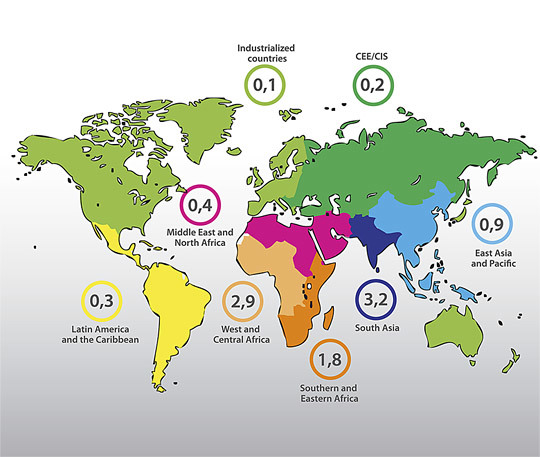Factshhet - child mortality
Historical archive
Published under: Stoltenberg's 2nd Government
Publisher: Office of the Prime Minister
Article | Last updated: 28/10/2013
MILLENNIUM DEVELOPMENT GOAL 4: REDUCING CHILD MORTALITY
The challenge – accelerating child survival
Latest figures show that 9.7 million children under-five are dying every year, down from over 12 million in 1990 Most of these children are dying in developing countries from preventable causes for which there are known and cost-effective interventions. Unless efforts are increased there will be little hope of averting the additional 5.4 million child deaths per year needed to achieve MDG4 of a two-third reduction by 2015.

Estimated number of deaths (in million) occuring before the age of five in 2006. Source: UNICEF
Key facts – uneven and insufficient progress
- More than one billion children are severely deprived of at least one of the essential goods and services they require to survive, grow and develop – these include nutrition, water, sanitation facilities, access to basic health-care services, adequate shelter, education and information. As a result 9.7 million children under-five die every year. A further 3.3 million babies are stillborn.
- Most of the 25,000 children under-five that die each day are concentrated in the world’s poorest countries in sub-Saharan Africa and South Asia. The gap in child mortality versus the industrialised countries has increased to 29-fold with mortality rates of 175 and 6 per 1000 children respectively.
Causes of under-five child deaths.
Six conditions account for 70% to over 90% of all child deaths. These are: acute lower respiratory infections, mostly pneumonia (19%), diarrhoea (18%), malaria (8%), measles, (4%), HIV/AIDS (3%), and neonatal conditions, mainly preterm birth, birth asphyxia, and infections (37%). The relative contribution of HIV/AIDS to the total mortality of children under-five, especially in sub-Saharan Africa, has also been increasing steadily. Malnutrition is present in more than half of the children who die beyond the first month of life.
Why are death tolls still high?
- Poor families are often unable to obtain even the most basic health care for their children. Poor or delayed care-seeking contributes to up to 70% of all under-five child deaths.
- Of the 12 countries where more than 20% of children die before their fifth birthday, nine have suffered a major armed conflict in the last five years.
- Countries with weak and fragile health systems have not been able to provide effective child survival strategies that are crucial to reduce under-five child deaths, and especially neonatal deaths. Basic health services have been lacking as well as nutrition, water supplies and sanitation facilities.
- The prevention of almost half a million deaths each year due to malaria endemic to children under-five in sub-Saharan Africa could have been prevented with the use of insecticide treated bed nets, which has been shown to reduce under-five mortality rates by up to 20%.
What can be done?
- Scaling up effective health services. More than 60% of all under-five child deaths can be avoided with proven low-cost preventive care and treatment. Preventive care includes; continuous breastfeeding, vaccination, adequate nutrition and - in Africa the use of insecticide treated bed-nets. The major causes of under-five deaths need to be treated rapidly e.g. with salt solutions for diarrhoea, or simple antibiotics for pneumonia and other infections. To reach the majority of children who today do not have access to this care, we need more and better trained and equipped health workers. Families and communities need further to know how best to bring up their children healthily and deal with sickness when it occurs.
- Political awareness, commitment and leadership is needed to ensure that child health receives the attention and resources required to accelerate progress towards MDG 4. Better information of the number of children dying and from what causes, will help leaders to decide on the best course of action.
Main sources for this fact-sheet: 2005 World Health Report: Make Every Mother and Child Count and The Lancet's Child Survival Series (2003).